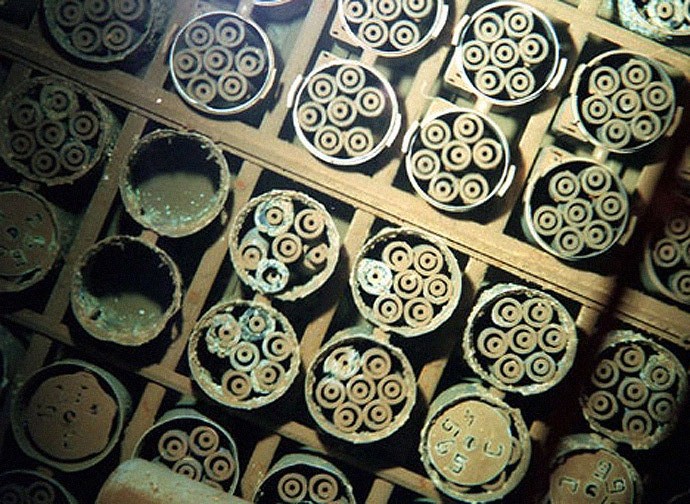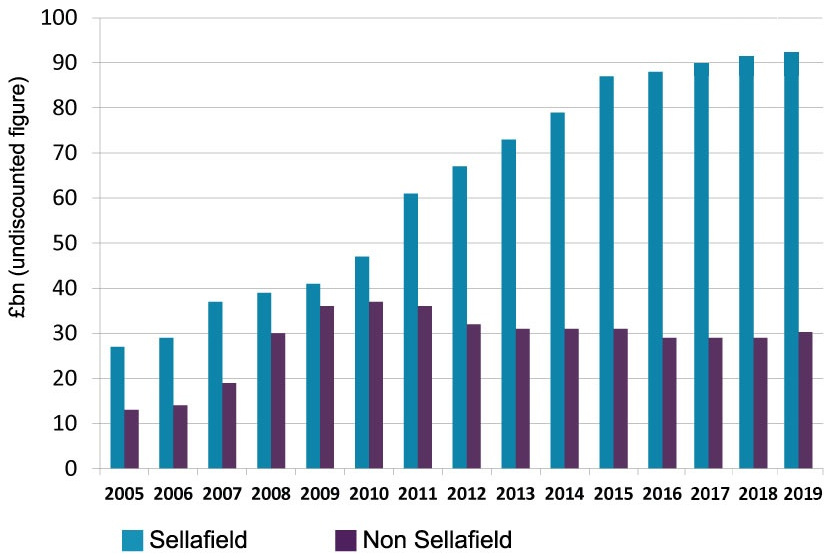|
Synroc
Synroc, a portmanteau of "synthetic rock", is a means of safely storing radioactive waste. It was pioneered in 1978 by a team led by Professor Ted Ringwood at the Australian National University, with further research undertaken in collaboration with ANSTO at research laboratories in Lucas Heights. Manufacture Synroc is composed of three titanate minerals – hollandite, zirconolite and perovskite – plus rutile and a small amount of metal alloy. These are combined into a slurry to which is added a portion of high-level liquid nuclear waste. The mixture is dried and calcined at to produce a powder. The powder is then compressed in a process known as hot isostatic pressing (HIP), where it is compressed within a bellows-like stainless steel container at temperatures of . The result is a cylinder of hard, dense, black synthetic rock. Comparisons If stored in a liquid form, nuclear waste can enter the environment and the waterways, and cause widespread damage. As a solid, t ... [...More Info...] [...Related Items...] OR: [Wikipedia] [Google] [Baidu] [Amazon] |
Radioactive Waste
Radioactive waste is a type of hazardous waste that contains radioactive material. It is a result of many activities, including nuclear medicine, nuclear research, nuclear power generation, nuclear decommissioning, rare-earth mining, and nuclear weapons reprocessing. The storage and disposal of radioactive waste is regulated by government agencies in order to protect human health and the environment. Radioactive waste is broadly classified into 3 categories: low-level waste (LLW), such as paper, rags, tools, clothing, which contain small amounts of mostly short-lived radioactivity; intermediate-level waste (ILW), which contains higher amounts of radioactivity and requires some shielding; and high-level waste (HLW), which is highly radioactive and hot due to decay heat, thus requiring cooling and shielding. Spent nuclear fuel can be processed in nuclear reprocessing plants. One third of the total amount have already been reprocessed. With nuclear reprocessing 96% of the spent fue ... [...More Info...] [...Related Items...] OR: [Wikipedia] [Google] [Baidu] [Amazon] |
High-level Radioactive Waste Management
High-level radioactive waste management addresses the handling of radioactive materials generated from nuclear power production and nuclear weapons manufacture. Radioactive waste contains both short-lived and long-lived radionuclides, as well as non-radioactive nuclides. In 2002, the United States stored approximately 47,000 tonnes of high-level radioactive waste. Among the constituents of spent nuclear fuel, neptunium-237 and plutonium-239 are particularly problematic due to their long half-lives of two million years and 24,000 years, respectively. Handling high-level radioactive waste requires sophisticated treatment processes and long-term strategies such as permanent storage, disposal, or conversion into non-toxic forms to isolate it from the biosphere. Radioactive decay follows the half-life rule, which means that the intensity of radiation decreases over time as the rate of decay is inversely proportional to the duration of decay. In other words, the radiation from a long- ... [...More Info...] [...Related Items...] OR: [Wikipedia] [Google] [Baidu] [Amazon] |
World Nuclear Association
World Nuclear Association is the international organization that promotes nuclear power and supports the companies that comprise the global nuclear industry. Its members come from all parts of the nuclear fuel cycle, including uranium mining, uranium conversion, uranium enrichment, nuclear fuel fabrication, plant manufacture, transport, and the disposal of used nuclear fuel, as well as electricity generation itself. Together, World Nuclear Association members are responsible for 70% of the world's nuclear power as well as the vast majority of world uranium, conversion and enrichment production. The Association says it aims to fulfill a dual role for its members: facilitating their interaction on technical, commercial and policy matters, and promoting wider public understanding of nuclear technology. It has a secretariat of around 30 staff. The Association was founded in 2001 on the basis of the Uranium Institute, itself founded in 1975. Membership World Nuclear Association ... [...More Info...] [...Related Items...] OR: [Wikipedia] [Google] [Baidu] [Amazon] |
England
England is a Countries of the United Kingdom, country that is part of the United Kingdom. It is located on the island of Great Britain, of which it covers about 62%, and List of islands of England, more than 100 smaller adjacent islands. It shares Anglo-Scottish border, a land border with Scotland to the north and England–Wales border, another land border with Wales to the west, and is otherwise surrounded by the North Sea to the east, the English Channel to the south, the Celtic Sea to the south-west, and the Irish Sea to the west. Continental Europe lies to the south-east, and Ireland to the west. At the 2021 United Kingdom census, 2021 census, the population was 56,490,048. London is both List of urban areas in the United Kingdom, the largest city and the Capital city, capital. The area now called England was first inhabited by modern humans during the Upper Paleolithic. It takes its name from the Angles (tribe), Angles, a Germanic peoples, Germanic tribe who settled du ... [...More Info...] [...Related Items...] OR: [Wikipedia] [Google] [Baidu] [Amazon] |
Sellafield
Sellafield, formerly known as Windscale, is a large multi-function nuclear site close to Seascale on the coast of Cumbria, England. As of August 2022, primary activities are nuclear waste storage, nuclear waste processing and storage and nuclear decommissioning. Former activities included nuclear power generation from 1956 to 2003, and nuclear fuel reprocessing from 1952 to 2022. The licensed site covers an area of , and comprises more than 200 nuclear facilities and more than 1,000 buildings. It is Europe's largest nuclear site and has the most diverse range of nuclear facilities in the world on a single site. The site's workforce size varies, and before the COVID-19 pandemic was approximately 10,000 people. The UK's National Nuclear Laboratory has its Central Laboratory and headquarters on the site. Originally built as a Royal Ordnance Factory in 1942, the site briefly passed into the ownership of Courtaulds for rayon manufacture following World War II, but was re-acquired b ... [...More Info...] [...Related Items...] OR: [Wikipedia] [Google] [Baidu] [Amazon] |
British Nuclear Fuels Limited
British may refer to: Peoples, culture, and language * British people, nationals or natives of the United Kingdom, British Overseas Territories and Crown Dependencies. * British national identity, the characteristics of British people and culture * British English, the English language as spoken and written in United Kingdom of Great Britain and Northern Ireland and, more broadly, throughout the British Isles * Celtic Britons, an ancient ethno-linguistic group * Brittonic languages, a branch of the Insular Celtic language family (formerly called British) ** Common Brittonic, an ancient language Other uses *People or things associated with: ** Great Britain, an island ** British Isles, an island group ** United Kingdom, a sovereign state ** British Empire, a historical global colonial empire ** Kingdom of Great Britain (1707–1800) ** United Kingdom of Great Britain and Ireland (1801–1922) * British Raj, colonial India under the British Empire * British Hong Kong, colonial H ... [...More Info...] [...Related Items...] OR: [Wikipedia] [Google] [Baidu] [Amazon] |
Plutonium
Plutonium is a chemical element; it has symbol Pu and atomic number 94. It is a silvery-gray actinide metal that tarnishes when exposed to air, and forms a dull coating when oxidized. The element normally exhibits six allotropes and four oxidation states. It reacts with carbon, halogens, nitrogen, silicon, and hydrogen. When exposed to moist air, it forms oxides and hydrides that can expand the sample up to 70% in volume, which in turn flake off as a powder that is pyrophoric. It is radioactive and can accumulate in bones, which makes the handling of plutonium dangerous. Plutonium was first synthesized and isolated in late 1940 and early 1941, by deuteron bombardment of uranium-238 in the cyclotron at the University of California, Berkeley. First, neptunium-238 (half-life 2.1 days) was synthesized, which then beta-decayed to form the new element with atomic number 94 and atomic weight 238 (half-life 88 years). Since uranium had been named after the planet Uranus ... [...More Info...] [...Related Items...] OR: [Wikipedia] [Google] [Baidu] [Amazon] |
Idaho National Laboratory
Idaho National Laboratory (INL) is one of the national laboratories of the United States Department of Energy and is managed by the Battelle Energy Alliance. Historically, the lab has been involved with nuclear research, although the laboratory does other research as well. Much of current knowledge about how nuclear reactors behave and misbehave was discovered at what is now Idaho National Laboratory. John Grossenbacher, former INL director, said, "The history of nuclear energy for peaceful application has principally been written in Idaho". The present facility resulted from the 2005 merger of two neighboring laboratories, the National Engineering and Environmental Laboratory, and the Idaho site of the western branch of Argonne National Laboratory (Argonne-West). Various organizations have built more than 50 reactors at what is commonly called "the Site", including the ones that gave the world its first usable amount of electricity from nuclear power and the power plant fo ... [...More Info...] [...Related Items...] OR: [Wikipedia] [Google] [Baidu] [Amazon] |
United States Department Of Energy
The United States Department of Energy (DOE) is an executive department of the U.S. federal government that oversees U.S. national energy policy and energy production, the research and development of nuclear power, the military's nuclear weapons program, nuclear reactor production for the United States Navy, energy-related research, and energy conservation. The DOE was created in 1977 in the aftermath of the 1973 oil crisis. It sponsors more physical science research than any other U.S. federal agency, the majority of which is conducted through its system of National Laboratories. The DOE also directs research in genomics, with the Human Genome Project originating from a DOE initiative. The department is headed by the secretary of energy, who reports directly to the president of the United States and is a member of the Cabinet. The current secretary of energy is Chris Wright, who has served in the position since February 2025. The department's headquarters are in sou ... [...More Info...] [...Related Items...] OR: [Wikipedia] [Google] [Baidu] [Amazon] |
Leaching (metallurgy)
Leaching is a process widely used in extractive metallurgy where ore is treated with chemicals to convert the valuable metals within the ore, into soluble salts while the impurity remains insoluble. These can then be washed out and processed to give the pure metal; the materials left over are commonly known as tailings. Compared to pyrometallurgy, leaching is easier to perform, requires less energy and is potentially less harmful as no gaseous pollution occurs. Drawbacks of leaching include its lower efficiency and the often significant quantities of waste effluent and tailings produced, which are usually either highly acidic or alkali as well as toxic (e.g. bauxite tailings). There are four types of leaching: # Cyanide leaching (e.g. gold ore) # Ammonia leaching (e.g. crushed ore) # Alkali leaching (e.g. bauxite ore) # Acid leaching (e.g. sulfide ore) Leaching is also notable in the extraction of rare earth elements, which consists of lanthanides, yttrium and scandium. ... [...More Info...] [...Related Items...] OR: [Wikipedia] [Google] [Baidu] [Amazon] |
Australian Broadcasting Corporation
The Australian Broadcasting Corporation (ABC) is Australia’s principal public service broadcaster. It is funded primarily by grants from the federal government and is administered by a government-appointed board of directors. The ABC is a publicly-owned statutory organisation that is politically independent and accountable; for example, through its production of annual reports, and is bound by provisions contained within the Public Interest Disclosure Act 2013 and the Public Governance, Performance and Accountability Act 2013, with its charter enshrined in legislation, the ''Australian Broadcasting Corporation Act 1983''. ABC Commercial, a profit-making division of the corporation, also helps generate funding for content provision. The ABC was established as the Australian Broadcasting Commission on 1 July 1932 by an Act of Federal Parliament. It effectively replaced the Australian Broadcasting Company, a private company established in 1924 to provide programming for A ... [...More Info...] [...Related Items...] OR: [Wikipedia] [Google] [Baidu] [Amazon] |






